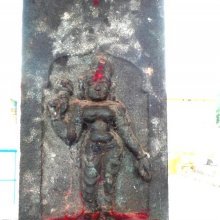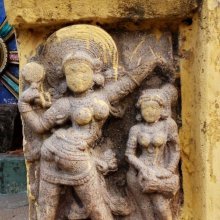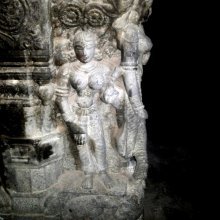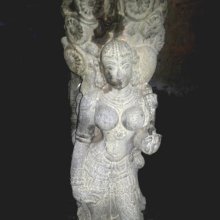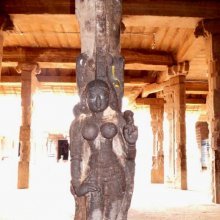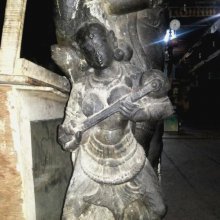Nartaki, Nartakī: 7 definitions
Introduction:
Nartaki means something in Hinduism, Sanskrit, Marathi, Hindi. If you want to know the exact meaning, history, etymology or English translation of this term then check out the descriptions on this page. Add your comment or reference to a book if you want to contribute to this summary article.
Images (photo gallery)
(+9 more images available)
In Hinduism
Chandas (prosody, study of Sanskrit metres)
Source: Shodhganga: a concise history of Sanskrit Chanda literatureNartakī (नर्तकी) is the name of a Sanskrit metre (chandas) to which Hemacandra (1088-1173 C.E.) assigned the alternative name of Kuṭila-gati in his auto-commentary on the second chapter of the Chandonuśāsana. Hemacandra gives these alternative names for the metres by other authorities (like Bharata), even though the number of gaṇas or letters do not differ.
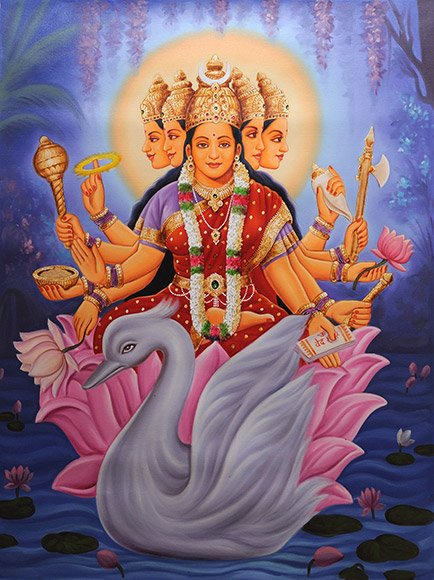
Chandas (छन्दस्) refers to Sanskrit prosody and represents one of the six Vedangas (auxiliary disciplines belonging to the study of the Vedas). The science of prosody (chandas-shastra) focusses on the study of the poetic meters such as the commonly known twenty-six metres mentioned by Pingalas.
Natyashastra (theatrics and dramaturgy)
Source: Wisdom Library: Nāṭya-śāstraNartakī (नर्तकी, “dancers ”) refers to one of the classes of “women” (strī) who have dealings with the king, according to the Nāṭyaśāstra chapter 34. Accordingly, “women who have beautiful limbs, are conversant with the sixty-four arts and crafts (kalā), are clever, courteous in behaviour, free from female diseases, always bold, free from indolence, inured to hard work, capable of practising various arts and crafts, skilled in dancing and songs, who excel by their beauty, youthfulness, brilliance and other qualities all other women standing by, are known as female dancers (nartakī)”.

Natyashastra (नाट्यशास्त्र, nāṭyaśāstra) refers to both the ancient Indian tradition (shastra) of performing arts, (natya—theatrics, drama, dance, music), as well as the name of a Sanskrit work dealing with these subjects. It also teaches the rules for composing Dramatic plays (nataka), construction and performance of Theater, and Poetic works (kavya).
Purana and Itihasa (epic history)
Source: archive.org: Shiva Purana - English TranslationNartakī (नर्तकी) refers to “dancing girls” (suitable for an festival ceremony), according to the Śivapurāṇa 2.3.30 (“The Celebration of Pārvatī’s Return”).—Accordingly, as Brahmā narrated to Nārada: “On hearing that Pārvatī was returning, Menā and Himavat excessively delighted went ahead seated in a divine vehicle. [...] The auspicious water-pot was placed in the main highway decorated with sandal paste, aguru, musk and branches of trees with fruits. The priests, Brahmins and sages reciting the Vedas, dancing girls (nartakī), all went ahead seated on lofty elephants to receive her. All round stumps of plantain trees were fixed. [...]”.

The Purana (पुराण, purāṇas) refers to Sanskrit literature preserving ancient India’s vast cultural history, including historical legends, religious ceremonies, various arts and sciences. The eighteen mahapuranas total over 400,000 shlokas (metrical couplets) and date to at least several centuries BCE.
Languages of India and abroad
Marathi-English dictionary
Source: DDSA: The Aryabhusan school dictionary, Marathi-Englishnartakī (नर्तकी).—f A female dancer or singing girl, an actress.
Marathi is an Indo-European language having over 70 million native speakers people in (predominantly) Maharashtra India. Marathi, like many other Indo-Aryan languages, evolved from early forms of Prakrit, which itself is a subset of Sanskrit, one of the most ancient languages of the world.
Sanskrit dictionary
Source: Cologne Digital Sanskrit Dictionaries: Monier-Williams Sanskrit-English Dictionary1) Nartakī (नर्तकी):—[from nartaka > narta] f. (cf. [Pāṇini 3-1, 145; Kāśikā-vṛtti]) a female dancer, actress, singing girl, [Kāvya literature; Purāṇa] etc. (-tva n., [Vikramāṅkadeva-carita, by Bilhaṇa])
2) [v.s. ...] a female elephant, [cf. Lexicographers, esp. such as amarasiṃha, halāyudha, hemacandra, etc.]
3) [v.s. ...] a peahen, [Horace H. Wilson]
4) [v.s. ...] a kind of perfume, [cf. Lexicographers, esp. such as amarasiṃha, halāyudha, hemacandra, etc.]
Sanskrit, also spelled संस्कृतम् (saṃskṛtam), is an ancient language of India commonly seen as the grandmother of the Indo-European language family (even English!). Closely allied with Prakrit and Pali, Sanskrit is more exhaustive in both grammar and terms and has the most extensive collection of literature in the world, greatly surpassing its sister-languages Greek and Latin.
Hindi dictionary
Source: DDSA: A practical Hindi-English dictionaryNartakī (नर्तकी):—(nf) a female dancer, dancing girl; ~,[rāja] a court dancer.
...
Kannada-English dictionary
Source: Alar: Kannada-English corpusNartaki (ನರ್ತಕಿ):—
1) [noun] a female dancer.
2) [noun] a division of an army.
3) [noun] (musc.) a musical mode.
Kannada is a Dravidian language (as opposed to the Indo-European language family) mainly spoken in the southwestern region of India.
See also (Relevant definitions)
Starts with: Nartakika, Nartakitva.
Full-text: Nartanagati, Nartanagarti, Nartini, Nartakitva, Shvun, Kutilagati, Stri, Nartaka, Upasena, Patra, Ranga, Nritya.
Relevant text
Search found 9 books and stories containing Nartaki, Nartakī; (plurals include: Nartakis, Nartakīs). You can also click to the full overview containing English textual excerpts. Below are direct links for the most relevant articles:
Gati in Theory and Practice (by Dr. Sujatha Mohan)
Importance of Gati in Uparūpakas < [Chapter 3 - Application of gati in Dṛśya-kāvyas]
Gati performed in Lāsyāṅgas < [Chapter 3 - Application of gati in Dṛśya-kāvyas]
Reference to Nāṭya, Nṛtta and Nṛtya Gati in Sanskrit dramas < [Chapter 3 - Application of gati in Dṛśya-kāvyas]
Harshacharita (socio-cultural Study) (by Mrs. Nandita Sarmah)
Part 4: Relation Among the Castes < [Chapter 2 - Caste System]
Namasmarana - A Universal Sadhana (by Narayana Kasturi)
C. Sweetness Of Namasmarana < [Significance And Power Of Namasmarana]
Abhinaya-darpana (English) (by Ananda Coomaraswamy)
Natyashastra (English) (by Bharata-muni)
